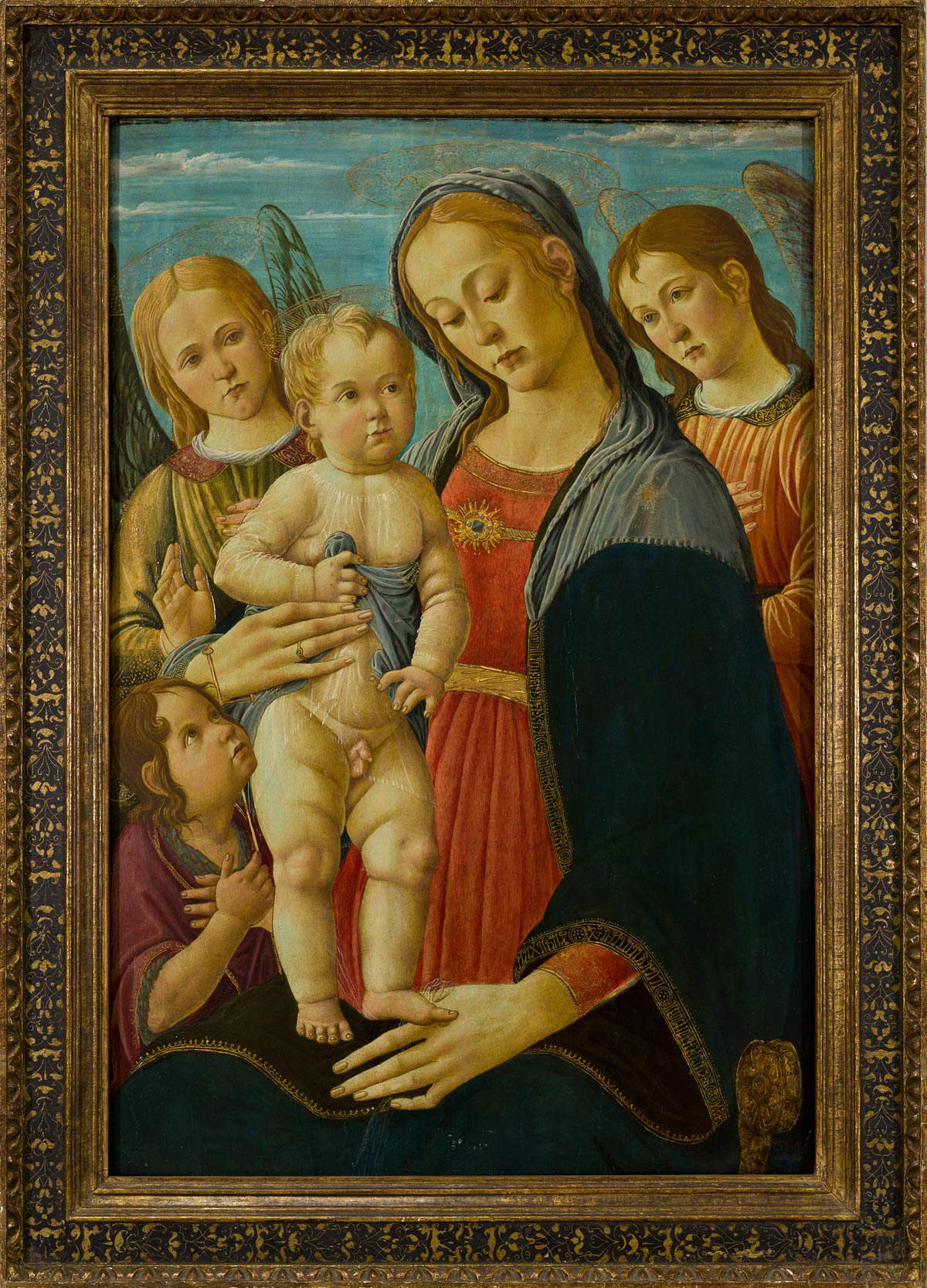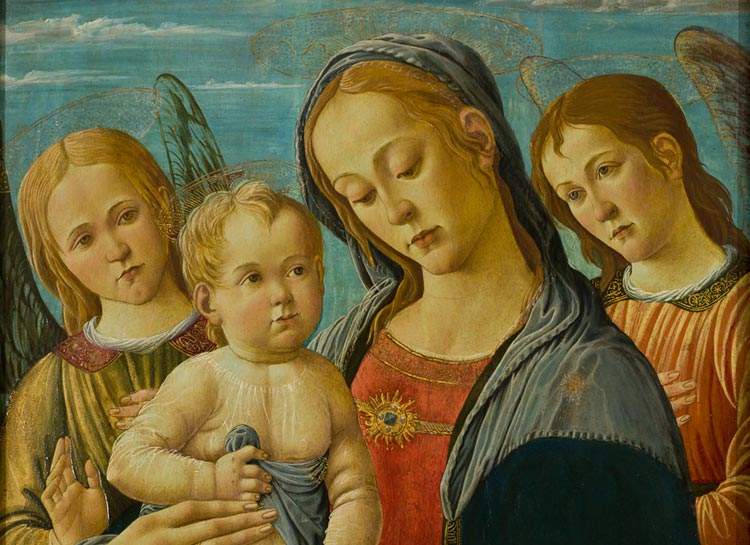Story of Jacopo del Sellaio's table seized by the Nazis and found after 80 years
“At 93, I had lost hope of seeing it resurface.” these are the words of Grete Unger Heinz, the owner of a masterpiece by Jacopo del Sellaio (Florence, 1443 - 1493) that had been seized by the Nazis but has resurfaced in recent months, and is now on display at the Villa Cerruti in Rivoli, home to the Cerruti Collection, or the collection of entrepreneur Francesco Federico Cerruti (Genoa, 1922 - Turin, 2015), now managed by the Cerruti Foundation and part of the museum hub of Rivoli Castle. It is a Madonna and Child, St. John and Two Angels, dated 1480-1485, a luminous example of second-generation Florentine Renaissance painting (that of Botticelli, Signorelli, Domenico del Ghirlandaio).
It was Cerruti himself who had purchased the Renaissance painting: he had wanted it badly and it was one of his favorite paintings, so much so that he placed it next to his bed in the Villa’s tower room, a space in which he had arranged several devotional works from his collection for purposes of intimate recollection. Cerruti had bought the panel in 1987 on the market (from an antiquarian who in turn had won the work at auction at Christie ’s in 1985), without knowing what the work’s background was. Indeed, he could not have known that the painting was owned by the heirs of the entrepreneur Gustav Arens (Reichenau, 1867 - Vienna, 1936), who purchased it in the first weeks of 1936 from a Viennese antiquarian, Galerie Sankt Lucas, and then entrusted it to the Akademie der bildenden Künste in Vienna because it was in need of restoration: it was on that occasion that art historian Emmerich Schaffran attributed the work to Jacopo del Sellaio (previously it had in fact been assigned to Raffaellino del Garbo). When Arens passed away in 1936, the panel was inherited by Gustav’s daughter Ann Arens, who had married Friedrich Unger: however, in 1938, the Nazis confiscated the work and released it only after payment of a high ransom.
 |
| Jacopo del Sellaio, Madonna and Child, St. John and Two Angels (1480-1485) |
The Jewish Unger-Arens family was forced to leave Austria in 1938 due to a deportation order against them (Friedrich, moreover, spent two months in prison as a political prisoner, and was released in exchange for shares in one of his companies).Friedrich, Ann and their daughters Grete and Gitte first traveled to France and then reached the United States in May 1939. The works in the collection (which included important pieces, mainly by Italian and Flemish artists: among others, Tintoretto, Francesco Guardi, Lucas Cranach, and Jacob van Ruisdael), first seized by the Nazis, had been freed only after the payment of the ransom mentioned above (of one hundred thousand francs), and the family managed to bring them to Paris. However, the family was unable to get them to America as well because of customs problems: thus, in 1942, it was easy for the Nazis (who had occupied France in the meantime) to requisition the Unger’s entire collection. Once the war was over, the family managed to recover part of their collection, but missing from the roll call was, among others, the painting by Jacopo del Sellaio, which was to reappear in 1974 at a Swiss antiquarian, Galerie Fischer in Lucerne, and then to be auctioned at the aforementioned 1985 auction.
Meanwhile, as mentioned, the painting was purchased by Cerruti: after his death, his collection was entrusted to Castello di Rivoli, in an agreement formulated in 2016 and then formalized in 2018. Since the latter date, the Castello di Rivoli has conducted research on the works in the collection: these investigations have made it possible to trace the legitimate owners of the panel by Jacopo del Sellaio. Thus, in 2018, the Cerruti Foundation got in touch with theHolocaust Claims Processing Office in New York (the body that handles matters related to inheritances taken from Jews by the Nazis and then dispersed), and the family’s heirs were identified, namely Grete Unger Heinz, the youngest daughter of Friedrich and Ann, and her sister Gitta’s children, namely Karen Meier-Reeds, Andrea Meier and Alan Meier.
The matter was concluded in 2020, after two years of negotiations between the Cerruti Foundation and the Unger heirs, who granted the Foundation permission to keep the painting to keep the Cerruti Collection intact and to display it at the Cerruti Villa, but with a commitment to recall the dramatic events that devastated Europe at the time and to tell the troubled story of the painting and the Unger-Arens family. The heirs were then also guaranteed adequate financial compensation (which has not been disclosed) and high-quality reproductions of the panel by Jacopo del Sellaio. The work can therefore be admired by all in the Rivoli villa.
Grete Unger Heinz, who now lives in Carmel, California, made no secret of her satisfaction: “At almost 93 years old, I had lost hope that this beloved Italian Renaissance painting belonging to my parents would ever resurface. I am delighted not only that the Cerruti Foundation has reached a fair agreement with the heirs of the Unger family, including a full account of the troubled history of the painting, but also that I will still be able to see the work itself at the Rivoli Castle Museum in my lifetime.”
“I am delighted that the Cerruti Foundation, the heirs of Ann and Friedrich Unger, and our Museum were able to successfully resolve a decades-long request for the return of Holocaust victims’ property,” said Carolyn Christov-Bakargiev, director of the Rivoli Castle. “Through our research into the provenance of the Cerruti Collection, and thanks to the Holocaust Claims Office (HCPO) in New York, we were able to identify the heirs of this Renaissance painting lost during World War II, compensate them for their loss, and preserve the painting at the museum for public enjoyment. This work by Jacopo del Sellaio, so beloved by its original owners and also by Francesco Federico Cerruti, who acquired it in 1987 without knowing its troubled past, has finally found peace.”
 |
| Story of Jacopo del Sellaio's table seized by the Nazis and found after 80 years |
Warning: the translation into English of the original Italian article was created using automatic tools. We undertake to review all articles, but we do not guarantee the total absence of inaccuracies in the translation due to the program. You can find the original by clicking on the ITA button. If you find any mistake,please contact us.




























